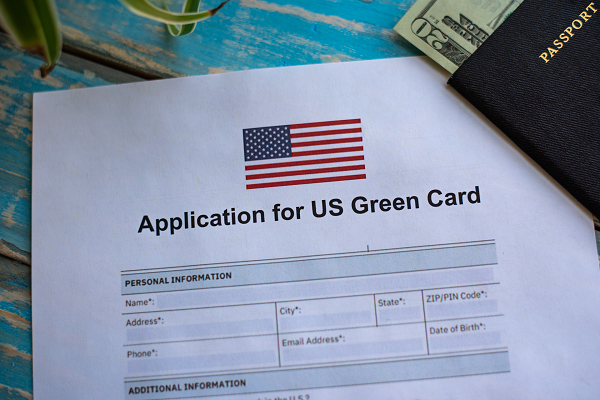Are you dreaming of a brighter future in the land of opportunity, the United States of America? The US Golden Visa, often referred to as the EB-5 Investor Visa program, is your golden ticket to making this dream a reality.
A USA Golden Visa is a special immigration program that offers a pathway for foreign investors and their families to obtain lawful permanent residency in the United States.
This program, officially known as the EB-5 Immigrant Investor Program, allows individuals to invest a certain amount of money in job-creating businesses in the U.S. In return, they can secure a “golden” ticket to live, work, and study anywhere in the country. It’s a sought-after opportunity for those looking to enjoy the American way of life while contributing to the nation’s economic growth.
In this guide, we will explain the US Golden Visa program in detail. We’ll talk about who can apply, the advantages, and how it can help you start a new life in the United States. Make sure you read carefully to get all the important details.
Without further ado, let’s proceed…
What is the US Golden Visa
The term “US Golden Visa” typically refers to the EB-5 Immigrant Investor Program, which is a United States visa program that provides a path to lawful permanent residency (green card) for foreign nationals who make a significant investment in a qualifying commercial enterprise in the United States.
This visa program is often dubbed the “Golden Visa” because it allows investors and their immediate family members (spouse and unmarried children under 21) to obtain permanent residency in the United States, which can eventually lead to citizenship, under certain conditions.
Types of US Golden Visa
The US Golden Visa, a sought-after immigration pathway, has gained immense popularity among foreign investors and entrepreneurs seeking to live and work in the United States. This visa program offers a unique opportunity for individuals and their families to obtain permanent residency in the US by making qualifying investments.
We will delve into the different types of US Golden Visa programs, shedding light on the various options available to prospective investors.
1. EB-5 Immigrant Investor Program:
The EB-5 Immigrant Investor Program is the quintessential US Golden Visa option. Under this program, foreign investors are required to invest a minimum of $1.8 million in a new commercial enterprise that creates at least 10 full-time jobs for qualified US workers. If the investment is made in a targeted employment area (TEA), which includes rural areas or regions with high unemployment rates, the minimum investment is reduced to $900,000. Successful applicants and their immediate families are granted conditional green cards, which can later be converted into permanent residency.
2. E-2 Treaty Investor Visa:
Although not officially categorized as a “Golden Visa” program, the E-2 Treaty Investor Visa offers foreign nationals the opportunity to invest in and manage a US-based business. To qualify, investors must come from a country that has a qualifying treaty with the United States. While this visa does not provide direct paths to permanent residency, it can be an attractive option for those looking to establish and operate businesses in the US.
3. L-1 Intracompany Transfer Visa:
The L-1 Intracompany Transfer Visa is designed for multinational companies seeking to transfer key employees to their US offices. While it doesn’t provide direct permanent residency, it offers a pathway through which individuals can eventually obtain a green card. This visa is suitable for managers, executives, and employees with specialized knowledge.
4. EB-1C Multinational Executive or Manager Visa:
The EB-1C visa is specifically designed for multinational executives and managers who have been employed by a foreign company for at least one year and are being transferred to a US office or affiliate. This visa leads to permanent residency and can be considered a more direct route to a green card for eligible individuals.
5. Regional Center EB-5 Program:
Within the broader EB-5 program, the Regional Center EB-5 Program allows investors to invest in designated regional centers that pool funds for large-scale projects. These projects typically have a lower job creation requirement, making it easier for investors to meet the criteria. This program is a popular choice among investors who prefer a more passive investment approach.
Requirements to Apply for US Golden Visa
The US Golden Visa program, officially known as the EB-5 Immigrant Investor Program, offers foreign investors and their families a pathway to obtain permanent residency in the United States.
This program has gained popularity among individuals seeking to live, work, and invest in the United States. To apply for the US Golden Visa, there are specific requirements and steps that investors must meet and follow.
We outlined the key requirements to apply for the US Golden Visa below:
1. Investment Amount:
The primary requirement for the US Golden Visa program is making a qualifying investment in a new commercial enterprise. As of my last knowledge update in September 2021, there are two investment thresholds:
- $1.8 million: This is the standard investment amount required for most EB-5 investors. The investment must create or preserve at least 10 full-time jobs for qualifying U.S. workers.
- $900,000: If the investment is made in a Targeted Employment Area (TEA), which includes rural areas or areas with high unemployment rates, the minimum investment amount is reduced to $900,000.
2. Investment in a New Commercial Enterprise:
Investors must invest their capital in a new commercial enterprise that is established after November 29, 1990, or in certain cases, in a troubled business.
3. Job Creation:
The investment must result in the creation or preservation of at least 10 full-time jobs for qualifying U.S. workers within two years of the investor’s admission to the United States as a conditional permanent resident. Alternatively, investments in troubled businesses may require preserving existing jobs.
4. At-Risk Investment:
Investors must demonstrate that their investment is “at risk” for the duration of their conditional permanent residency. This means the capital must be actively invested in the commercial enterprise and not guaranteed or secured by assets of the business.
5. Source of Funds:
Applicants must provide detailed documentation proving the lawful source of their investment funds. This documentation is crucial to ensure that the funds used for the investment have been obtained legally.
6. Conditional Permanent Residency:
Once the application is approved, investors and their immediate family members (spouse and unmarried children under 21) are granted conditional permanent residency for two years. During this period, they have the rights and responsibilities of U.S. permanent residents.
7. Removal of Conditions:
Within the 90-day period immediately before the second anniversary of obtaining conditional permanent residency, investors must file a petition to remove these conditions and provide evidence that the investment has been maintained and job creation requirements have been met.
8. Medical Examination and Security Checks:
As part of the application process, all applicants, including family members, must undergo a medical examination and background security checks.
Required Documents to Apply for US Golden Visa
The U.S. Golden Visa program, officially known as the EB-5 Immigrant Investor Program, offers a pathway to obtain a U.S. green card for foreign investors and their immediate families.
To apply for this visa program, there are specific documents that applicants must submit as part of the application process. These documents are essential for demonstrating eligibility and ensuring a smooth application process.
Here is a list of the required documents to apply for the U.S. Golden Visa:
1. Form I-526, Immigrant Petition by Alien Investor:
This is the initial petition that establishes your eligibility for the EB-5 program. It should be completed and submitted along with the required filing fee.
2. Proof of Investment:
Applicants must provide evidence of the investment they intend to make in a new commercial enterprise. This includes financial documents such as bank statements, wire transfer records, and evidence of the source of funds.
3. Business Plan:
A comprehensive business plan for the new commercial enterprise is required. This plan should outline the business’s structure, job creation projections, and how the investment will benefit the U.S. economy.
4. Documentation of the New Commercial Enterprise:
You need to provide documentation proving that you have invested or are actively in the process of investing the required capital into the new commercial enterprise. This can include organizational documents, lease agreements, contracts, and other relevant paperwork.
5. Proof of Job Creation:
One of the key requirements of the EB-5 program is the creation of jobs for U.S. workers. You should provide documentation, such as payroll records, I-9 forms, and tax documents, to demonstrate that the required jobs have been or will be created.
6. Personal Documents:
Applicants must submit personal documents, including a valid passport, birth certificate, marriage certificate (if applicable), and police clearance certificates from all countries of residence.
7. Medical Examination:
A medical examination conducted by a U.S. government-approved physician is required to ensure that you do not pose a public health risk.
8. Affidavit of Support (Form I-864):
If necessary, a U.S. citizen or lawful permanent resident family member may need to provide an Affidavit of Support to demonstrate that you will not become a public charge in the United States.
9. Photographs:
You will need to provide passport-sized photos as per the U.S. government’s specifications.
10. Filing Fees:
Payment of the required filing fees for each form and process is essential to initiate and process your application.
11. Consular Processing Documents:
If you are applying for the U.S. visa from abroad, you will need to complete additional documents related to consular processing.
12. Legal and Financial Documents:
Any additional legal or financial documents requested by U.S. Citizenship and Immigration Services (USCIS) during the application process must be provided promptly.
Step-by-Step Application Process for the US Golden Visa
The US Golden Visa program has become an increasingly popular avenue for foreign investors seeking to secure a foothold in the United States. Offering a pathway to lawful permanent residency, this program can be an attractive option for those looking to live, work, and invest in the United States. In this guide, we will walk you through the process of applying for a US Golden Visa, step by step.
Step 1: Determine Eligibility
Before you begin the application process for a US Golden Visa, it’s crucial to ascertain your eligibility. To qualify for this program, you typically need to invest a substantial amount of capital in the US economy. There are various investment options, such as investing in a new commercial enterprise or a regional center project. The minimum investment amounts can vary, so make sure you meet the specific requirements based on your chosen investment route.
Step 2: Choose Your Investment Route
As mentioned earlier, there are different investment routes available for the US Golden Visa program. You can either opt for the EB-5 Direct Investment program or the EB-5 Regional Center program. The choice depends on your preferences, risk tolerance, and investment goals. Consult with immigration experts or legal counsel to help you make an informed decision.
Step 3: Make Your Investment
Once you’ve selected your investment route, it’s time to fund your investment. Ensure that you meet the minimum capital requirements and that your investment complies with the program’s guidelines. This often involves working with financial professionals and project developers to ensure your investment aligns with the program’s objectives.
Step 4: File Form I-526
Form I-526, also known as the Immigrant Petition by Alien Investor, is the first official application you’ll submit as part of the US Golden Visa process. This form demonstrates your eligibility and the legality of your investment. Be prepared to provide extensive documentation, including investment details and proof of funds. USCIS will review your application to determine your eligibility.
Step 5: Conditional Permanent Residency
Upon approval of Form I-526, you and your immediate family members (spouse and children under 21) will be granted conditional permanent residency. This status is valid for two years. During this period, you are required to maintain your investment and ensure it creates the required jobs.
Step 6: File Form I-829
Within the 90-day window before your conditional permanent residency expires, you must file Form I-829, the Petition by Entrepreneur to Remove Conditions. This form seeks to remove the conditions on your permanent residency status by demonstrating that your investment has created the necessary jobs and met all program requirements.
Step 7: Achieve Unconditional Permanent Residency
Upon approval of Form I-829, you and your family members will obtain unconditional permanent residency in the United States. This status grants you the freedom to live, work, and study anywhere in the country without any restrictions.
Step 8: Pursue Citizenship (Optional)
While obtaining a US Golden Visa grants you permanent residency, it does not automatically lead to citizenship. If you wish to become a US citizen, you can apply for naturalization after meeting the necessary residency requirements and other criteria.
Perks of the US Golden Visa Program
The US Golden Visa program, officially known as the EB-5 Immigrant Investor Program, offers foreign investors a unique pathway to obtain a US green card by investing in job-creating ventures.
This program has gained immense popularity over the years, attracting individuals and families from around the world. In this article, we will explore the numerous advantages and benefits that the US Golden Visa program provides to eligible investors.
1. Investment Opportunities:
One of the primary benefits of the US Golden Visa program is the opportunity to invest in a wide range of businesses and projects. Investors can choose between regional center projects or direct investments, giving them the flexibility to select an investment option that aligns with their financial goals and risk tolerance.
2. Permanent Residency:
The US Golden Visa program provides a direct pathway to permanent residency in the United States for the investor, their spouse, and their unmarried children under the age of 21. This offers a long-term solution for those seeking to establish a foothold in the US.
3. Education:
Investors and their families can access some of the world’s top educational institutions in the United States, often at in-state tuition rates, providing an excellent opportunity for children to receive a world-class education.
4. Business Opportunities:
Holding a US green card through the Golden Visa program allows investors to explore business opportunities in the US market, fostering entrepreneurship and economic growth.
5. Quality Healthcare:
The United States is renowned for its advanced healthcare system. Golden Visa holders can benefit from top-notch medical facilities and healthcare services, ensuring the well-being of their families.
6. Tax Benefits:
The US tax system offers various benefits to residents and citizens. While tax implications can be complex, consulting with tax professionals can help Golden Visa holders optimize their tax strategy.
7. Freedom of Travel:
US Golden Visa holders can enjoy the freedom to travel to and from the United States without the need for additional visas or authorizations, making it easier to manage international business affairs and visit family abroad.
8. Access to Legal Protections:
As US residents, Golden Visa holders have access to the US legal system, which provides comprehensive legal protections for individuals and businesses.
9. Diverse Culture and Lifestyle:
The United States is a diverse and culturally rich nation, offering a wide range of experiences, from bustling urban centers to serene rural areas. Golden Visa holders can enjoy this diverse lifestyle.
10. Path to Citizenship:
After holding a green card for five years, Golden Visa investors may be eligible to apply for US citizenship, further solidifying their ties to the United States.
Frequently Asked Questions
1. How much do I need to invest in the EB-5 Program?
To qualify for the EB-5 Program, you generally need to invest a minimum of $1.8 million in a new commercial enterprise in the United States. However, if the investment is made in a targeted employment area (TEA), which is typically a rural area or an area with high unemployment, the minimum investment is reduced to $900,000.
2. What is a targeted employment area (TEA)?
A targeted employment area (TEA) is an area designated by the government as having high unemployment or being a rural area. Investments made in TEAs qualify for the lower minimum investment threshold of $900,000.
3. What is the process for obtaining a US green card through the EB-5 Program?
The process generally involves:
- Making the qualifying investment.
- Submitting an I-526 petition to the United States Citizenship and Immigration Services (USCIS).
- Upon approval, either going through consular processing or adjusting status within the United States.
- Conditional green cards are issued initially, and after two years, you can apply to remove the conditions through an I-829 petition.
4. Can my family members also get green cards through the EB-5 Program?
Yes, your spouse and unmarried children under the age of 21 are eligible for green cards under your EB-5 petition.
5. Is there a limit on the number of EB-5 visas issued each year?
Yes, there is a limit of 10,000 EB-5 visas issued annually, with 7,000 of those reserved for investors in TEAs.
6. What are the benefits of the EB-5 Program?
The benefits include the opportunity to obtain US green cards for you and your family, the ability to live and work anywhere in the United States, and access to education and healthcare benefits.
7. Are there any risks associated with the EB-5 Program?
Yes, there are investment risks involved, as there is no guarantee of a return on your investment. It’s essential to conduct due diligence on the project you’re investing in.
8. Can I run the business I invest in through the EB-5 Program?
Yes, you can be involved in the management of the business you invest in, but your primary purpose should be the investment itself.
9. How long does the EB-5 process take?
The time frame can vary, but it generally takes several years from the initial investment to obtaining a permanent green card.
10. Can I apply for US citizenship through the EB-5 Program?
Yes, after holding a green card for a certain number of years, typically five years, you can apply for US citizenship if you meet all other eligibility requirements.
Last Note
The US Golden Visa program, or EB-5 Immigrant Investor Program, offers a unique opportunity for foreign investors to obtain permanent residency in the United States.
Obtaining a US Golden Visa can be a complex process, but with careful planning, a solid investment strategy, and legal guidance, you can successfully secure your path to permanent residency in the United States. Meeting the program’s investment and job creation requirements is essential for a successful application.
It’s crucial to note that the U.S. Golden Visa program requirements and document checklist can change over time, so it’s advisable to consult the official USCIS website or seek guidance from an immigration attorney or a reputable EB-5 regional center to ensure that you have the most up-to-date information and proper guidance throughout the application process.
References
U.S. Citizenship and Immigration Services (USCIS): https://www.uscis.gov/eb-5
U.S. Department of State – Visa Bulletin: https://travel.state.gov
American Immigration Lawyers Association (AILA): https://www.aila.org
Invest In the USA (IIUSA): https://iiusa.org






